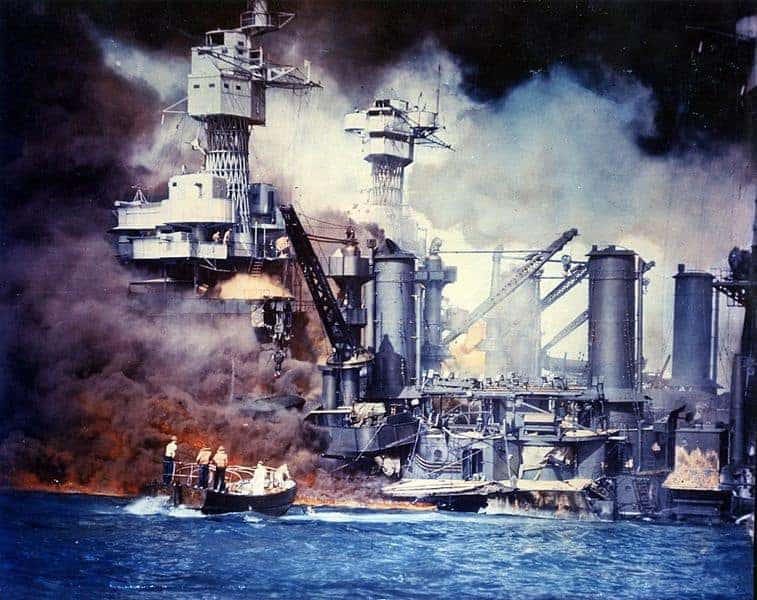Officially the United States was neutral during the early days of the Second World War. Beginning in 1938 the US government took a series of steps to attempt to force the Japanese out of China, later extending demands that the Japanese withdraw from Indochina. These steps were economic in nature, denying the Japanese materials needed to prosecute the war. In 1940, with war then raging in Europe, President Roosevelt ordered the United States Pacific Fleet to be placed in Hawaii, over the protests of its commander, Admiral James Richardson. Until that time the US Pacific fleet had been based on the west coast of the United States.
In the Atlantic, US aid to Britain had included the transfer of “surplus” aircraft, the transfer of fifty US destroyers in exchange for land rights to create naval and air bases on British held Atlantic islands, the Atlantic Charter, and American fleet and air units actively supporting the convoying of cargo ships bound for England. Roosevelt administration officials repeatedly sought out ways to circumvent the restrictions imposed by the Neutrality Act to provide direct aid to British. Unable to be involved in a shooting war FDR waged economic warfare in both the Atlantic and Pacific theaters. This eventually led to shooting encounters between US Navy destroyers and German U-boats, including the sinking of USS Reuben James by a German U-boat in October 1941, with the loss of 100 American lives. And it led to Pearl Harbor.

Here are ten actions taken by the United States which helped lead it into World War II.

Trade Restrictions and embargoes against Japan
When the Second Sino-Japanese War began the League of Nations, of which the United States was not a member, condemned the Japanese action, which led them to exit the League. The United States joined in the international calls for the Japanese to cease their aggression in Asia. In 1938 the United States began what would become a series of increasingly stringent trade restrictions in an effort to curb Japanese aggression and ambition in Southeast Asia. The United States also supplied the Chinese Nationalist forces fighting the Japanese with loans of money and with supplies.
In July of 1939 the United States gave Japan six months notice of its intent to withdraw from the 1911 treaty which governed trade between the two nations, allowing the US to establish an embargo against the Japanese Empire. Although the Japanese imported nearly 80% of its oil from the United States the American embargo did not restrict the sale of oil to the Japanese, at least not yet. In September of 1940 the United States extended the embargo to include the sale of scrap metal and copper to the Japanese, in response to Japan’s entry into Northern Indochina. In response the Japanese occupied the rest of Indochina.
The Japanese occupation of Indochina put them in a position to threaten British and Dutch possessions and to interfere with American shipping of supplies to the Chinese. In July of 1941 the Japanese reached an agreement with the Vichy government of France to allow Japanese occupation of key airfields in Indochina, a move which solidified their presence in the French colony and increased the threat to British and Dutch possessions. In response the United States froze Japanese assets in the US and closed the Panama Canal to Japanese shipping.
The United States also embargoed the shipping of oil and gasoline to Japan. An assessment by the Imperial Japanese Navy reported that the fleet had less than a two year supply of fuel for its ships. There was oil in the Dutch possession of Brunei, but the Japanese believed that an attack on the Dutch East Indies would lead to the United States going to war, leaving them exposed to an attack from the American held Philippines. Japanese plans for the attack on Pearl Harbor and elsewhere in the Pacific went forward as they continued to attempt to negotiate a diplomatic solution.
In the late spring of 1941 the decision was made to keep the Japanese consulate in Hawaii open, despite the closing of the consulates of both of Japan’s allies in the Tripartite Pact. The decision was made in part because US intelligence was collecting information from intercepts of Japanese radio transmissions. While these intercepts provided valuable information for US planners, they did not indicate that an attack on Pearl Harbor was in the works. Placing the fleet in Hawaii exposed it to Japanese attack, but the shallowness of the harbor was believed to prevent the use of torpedoes. The Japanese thought otherwise.

